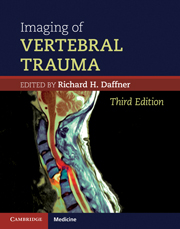Book contents
- Frontmatter
- Contents
- List of contributors
- Preface to the Third Edition
- Preface to the Second Edition
- Preface to the First Edition
- Acknowledgments
- 1 Overview of vertebral injuries
- 2 Anatomic considerations
- 3 Biomechanical considerations
- 4 Imaging of vertebral trauma I: indications and controversies
- 5 Imaging of vertebral trauma II: radiography, computed tomography, and myelography
- 6 Imaging of vertebral trauma III: magnetic resonance imaging
- 7 Mechanisms of injury and their “fingerprints”
- 8 Radiologic “footprints” of vertebral injury: the ABCS
- 9 Vertebral injuries in children
- 10 Vertebral stability and instability
- 11 Normal variants and pseudofractures
- Index
9 - Vertebral injuries in children
Published online by Cambridge University Press: 21 April 2011
- Frontmatter
- Contents
- List of contributors
- Preface to the Third Edition
- Preface to the Second Edition
- Preface to the First Edition
- Acknowledgments
- 1 Overview of vertebral injuries
- 2 Anatomic considerations
- 3 Biomechanical considerations
- 4 Imaging of vertebral trauma I: indications and controversies
- 5 Imaging of vertebral trauma II: radiography, computed tomography, and myelography
- 6 Imaging of vertebral trauma III: magnetic resonance imaging
- 7 Mechanisms of injury and their “fingerprints”
- 8 Radiologic “footprints” of vertebral injury: the ABCS
- 9 Vertebral injuries in children
- 10 Vertebral stability and instability
- 11 Normal variants and pseudofractures
- Index
Summary
Introduction
The prevalence of vertebral injuries in children has been reported at less than 1–2% of all pediatric fractures [1]. Spinal column injuries in children are rare compared with similar injuries in adults. Children account for less than 10% of all spinal column injuries; however, the mortality rate of spinal column injuries in children is significantly higher than in adults [2–4]. Children differ from adults both in the type and the outcome of spinal injuries. Clearing the spine in children can be especially difficult because of the relative rarity of these injuries, the inability of young children to communicate, and the presence of various normal variants such as synchondroses and pseudosubluxation. In addition, the vulnerability of children to the deleterious effects of radiation exposure requires a rational approach to the imaging of spine trauma in this population. The cervical spine is the most common site of spinal injuries in children, especially those younger than eight years of age [5].
This chapter reviews the epidemiology of pediatric cervical spine injury, the normal development of the cervical spine, and its normal variants in children. We propose an algorithm for imaging of cervical spine trauma in children and discuss specific cervical spine injuries that are more common in the pediatric population. This is followed by a brief discussion of thoracic and lumbar trauma in the pediatric age group.
- Type
- Chapter
- Information
- Imaging of Vertebral Trauma , pp. 165 - 180Publisher: Cambridge University PressPrint publication year: 2011



